The Art of the Post: The Rockwell Cover that Led to a Marriage
Modern art critics have often looked down their noses at Norman Rockwell’s realistic style of painting, dismissing his painstaking details as unnecessary and old fashioned. But for at least one person, the details in Rockwell’s painting led to a life-altering experience.
In this 1944 Post cover, Rockwell painted a pretty young girl asleep in bed at midnight on New Year’s Eve. Rather than go out partying, she dreams about her soldier boy overseas.
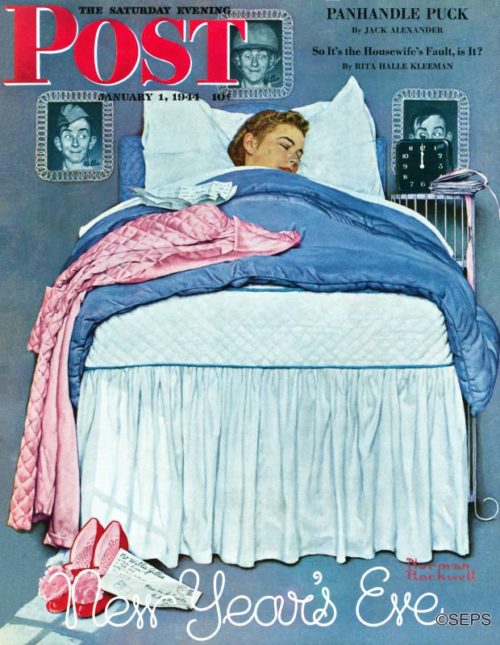
Rockwell literally selected the girl next door for his model. He asked his close friend and fellow illustrator, Mead Schaeffer, if Schaeffer’s sixteen-year-old daughter Lee would pose for the cover. Schaeffer lived just up the street from Rockwell in Vermont.
Ever the perfectionist, Rockwell also selected just the right details to tell his story. That clock on the bedside table shows us that it is midnight and the young girl is not out celebrating in those fancy party shoes. The photos of her boyfriend — none other than Rockwell’s favorite GI, Willie Gillis — on the wall tell us why. But do extra details such as the envelope on the floor really make any difference?
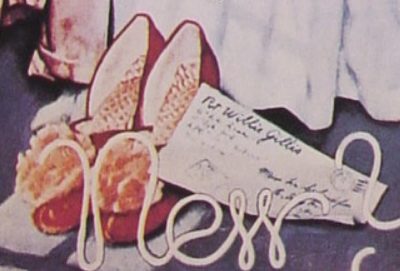
Rockwell was such a stickler for detail, when he painted that envelope he used Lee Schaeffer’s actual address. He assumed it would be too small and blurry to be legible when it was finally reproduced on the cover of the Post. The address was just one of the many details that Rockwell captured purely for his own satisfaction.
Unfortunately, Rockwell underestimated the resourcefulness of our young G.I.s. Soldiers were so smitten by the lovely Lee that they got out their magnifying glasses. Before long, letters started streaming in to Lee Schaeffer at home. Lee’s mother became quite upset with Rockwell for putting her daughter’s address on the cover of the Post. She made sure that all of Lee’s fan mail went unanswered.
But that’s not the end of the story. A few years later, a young veteran named Bob Goodfellow, recently back from serving in the U.S. Navy Reserve on Iwo Jima, saw the famous cover. Like others before him, he fell in love with the slumbering girl. But unlike other soldiers, Goodfellow had an advantage. His fraternity brother knew the Schaeffer family and happened to be dating Lee’s sister Patricia. Goodfellow kept pestering his fraternity brother to arrange an introduction, and finally his persistence paid off. The fraternity brother gave in and arranged a double date with Lee and Patricia in New York City. Goodfellow met Lee on a blind date on December 3, 1949. Goodfellow must have made a good first impression because he was able to wrangle an invitation to Mead Schaeffer’s New Year’s party. There, Lee introduced Goodfellow to her parents, he passed the test, and the courtship began.
Goodfellow and Lee Schaeffer were married on March 16, 1951, and they remain happily married in Vermont today. Next March will be their 67th anniversary. The famous Rockwell cover of the Post that started it all is framed and hanging on the wall above Goodfellow’s desk.
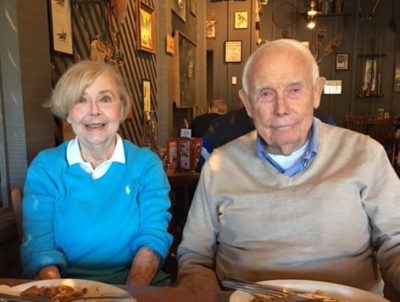
Many modern art critics have insisted that the tiny details in Rockwell’s paintings are pointless. They should keep their eyes and minds open. You can never tell where paying attention might lead.
Cover Gallery: Congrats, Graduates!
As you can see from these covers dating back to 1900, America has always celebrated educational milestones with great pride. We’ve always known that our grads would go on to do amazing things!
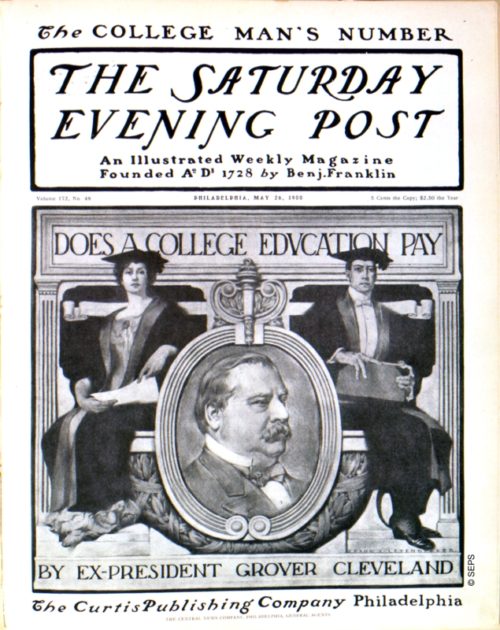
Frank X. Leyendecker
May 26, 1900
This cover of President Cleveland and two college graduates was Frank X. Leyendecker’s first cover for the Saturday Evening Post.
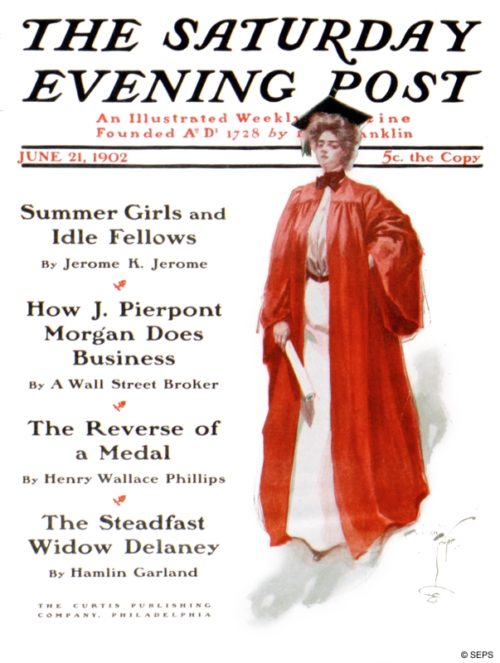
Harrison Fisher
June 21, 1902
The most important work of the early Post period was made up of the elegant paintings of Harrison Fisher. He frequently painted covers that simply presented a lovely woman. Occasionally a prop, like the diploma in this 1902 cover, implied a narrative, but the essential subject remained the woman herself.
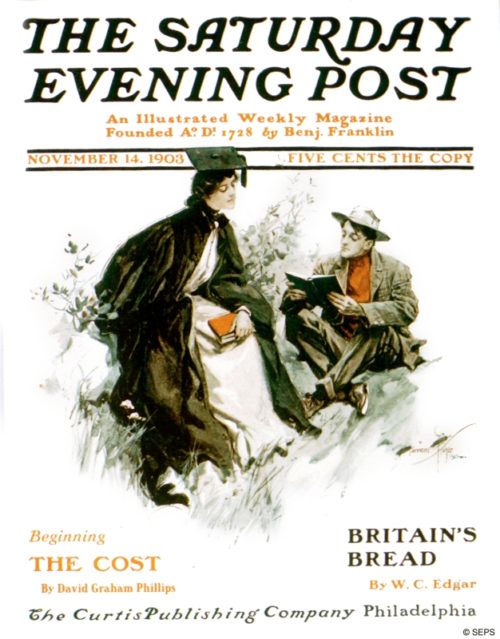
Harrison Fisher
November 14, 1903
This later Harrison Fisher cover shows a couple reading together. Couples doing something romantic was another common theme in Fisher’s covers. Since painting women was his specialty, the woman graduate still remains the focus of this cover.
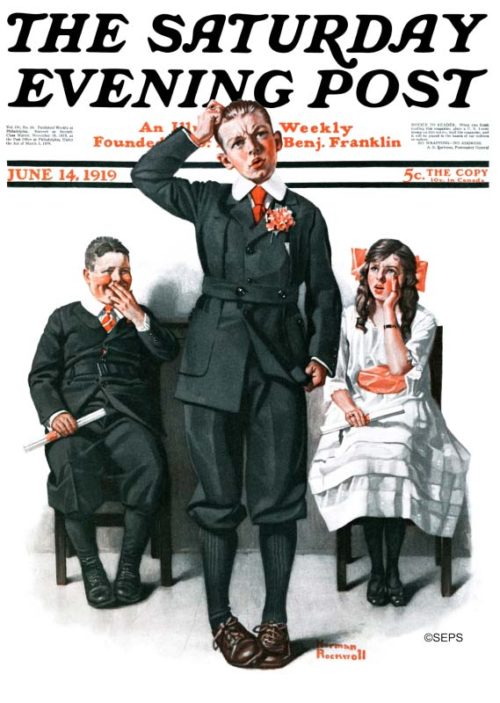
Norman Rockwell
June 14, 1919
This Rockwell cover shows a young student trying to remember his graduation speech. By the look on his face, he doesn’t hear the helpful hints or laughter coming from behind him.
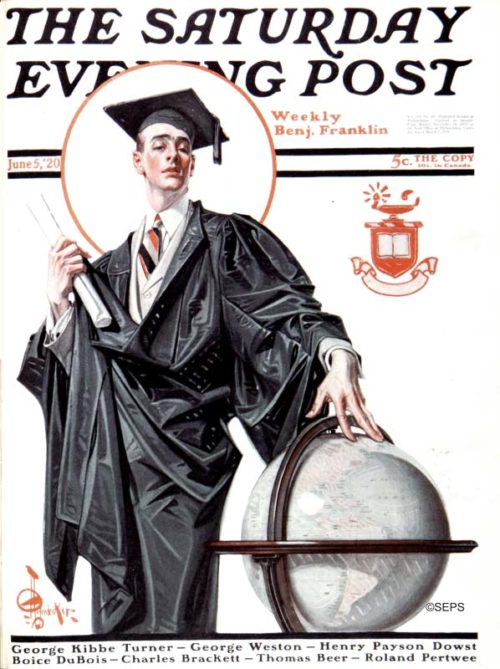
J.C. Leyendecker
June 5, 1920
This J.C. Leyendecker cover shows a college graduate ready to take on the world. Strong male figures were a trademark of many of Leyendecker’s Post covers.
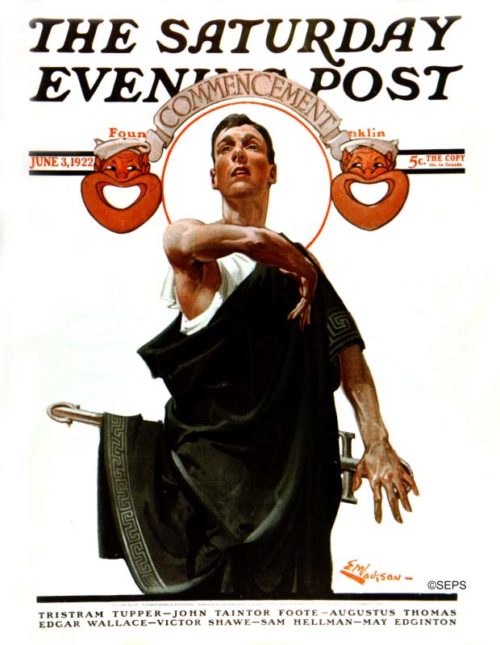
E.M. Jackson
June 3, 1922
This is one of more than 30 covers E.M. Jackson created in the 1920s. While Jackson was mostly known for his paintings of romantic women, he occasionally created a cover focused on a man, like this graduate dressed as a Roman, giving his commencement speech.
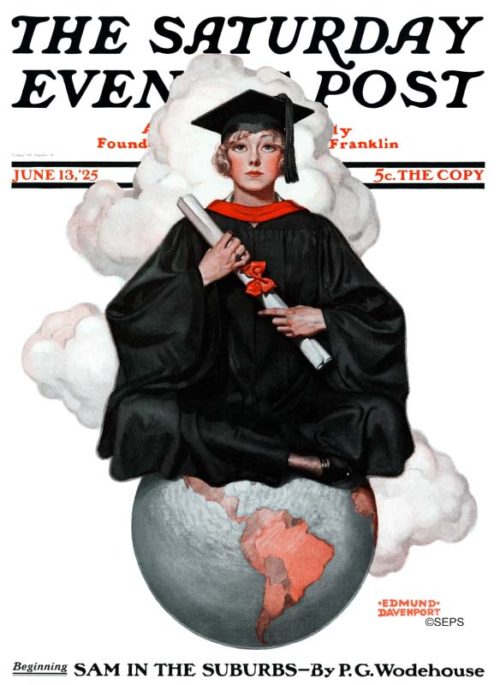
Edmund Davenport
June 13, 1925
This is Edmund Davenport’s third and final cover for the Saturday Evening Post. The clouds behind this graduate make this cover unique and complex compared to Davenport’s other two covers, which have more simple backgrounds.
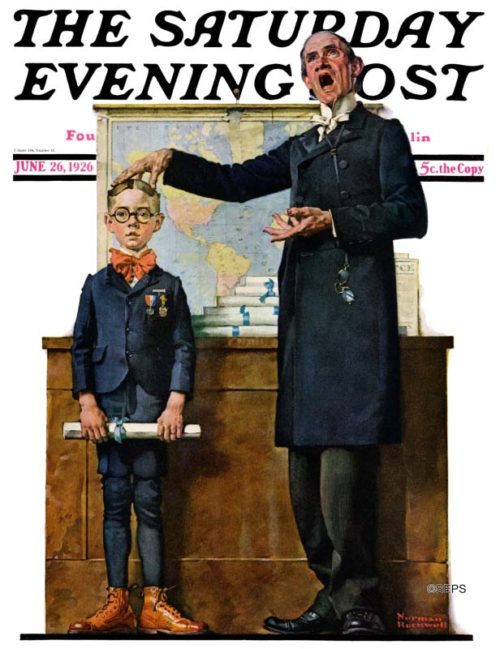
Norman Rockwell
June 26, 1926
In this Rockwell cover a professor hands a young boy his diploma and praises his hard work. It’s assumed that he’s the first in his class based on the large stack of diplomas behind him and the medals on his jacket.
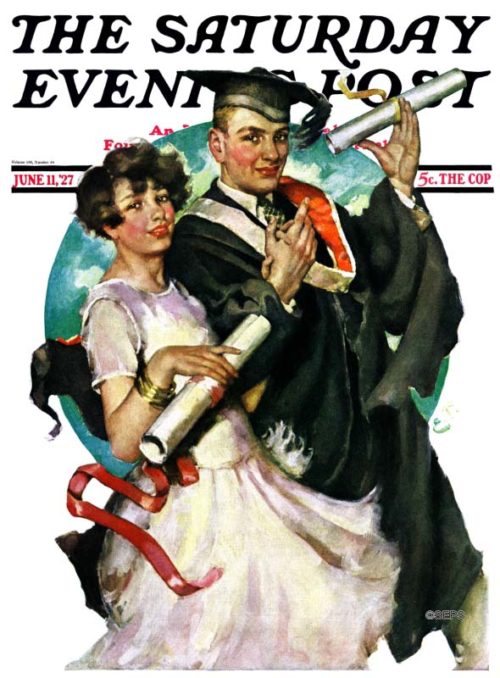
Ellen Pyle
June 11, 1927
This cover was done by one of the Post’s most prolific female artists, Ellen Pyle. Her early Post covers were simple portraits of women. Later on, her work became more detailed and many of her covers have the subject in front of a large, colored circle in the background, just like these graduates on her 1927 cover.
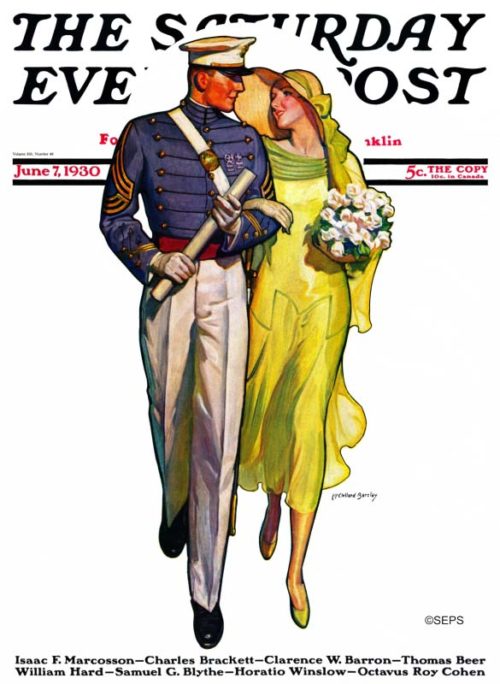
McClelland Barclay
June 7, 1930
This McClelland Barclay cover of a military school graduate and his girl is similar to nearly every other Barclay Post cover. Barclay became well known for his ability to paint strikingly beautiful women in a rather simple setting using bold colors. Barclay painted a total of five Saturday Evening Post covers, and all but one depicts a vibrant couple with an empty background.
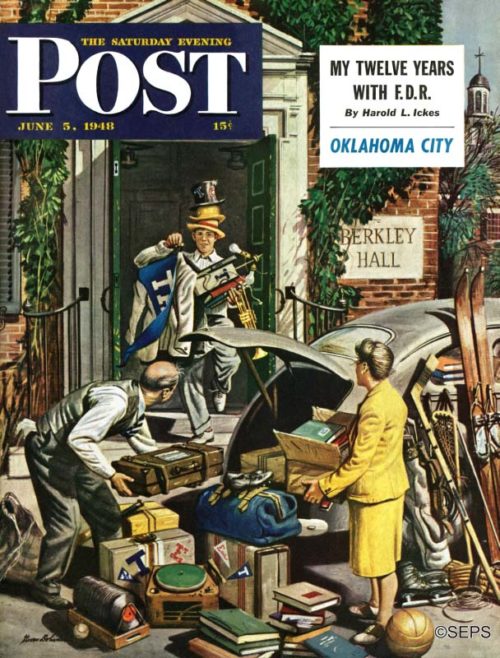
Stevan Dohanos
June 5, 1948
Steve Dohanos’ two sons, Peter and Paul, were in an Eastern boys’ school when he took the family car up to help them move home. A passenger car, he learned, is no proper vehicle for such a job. The artist made his sketches on the Yale campus, but rearranged things to suit his purposes. The boy is George Ritter, of Westport, Connecticut, no Yale man. The artist didn’t use a Yale man, on the remarkable theory that none would like to cut class.
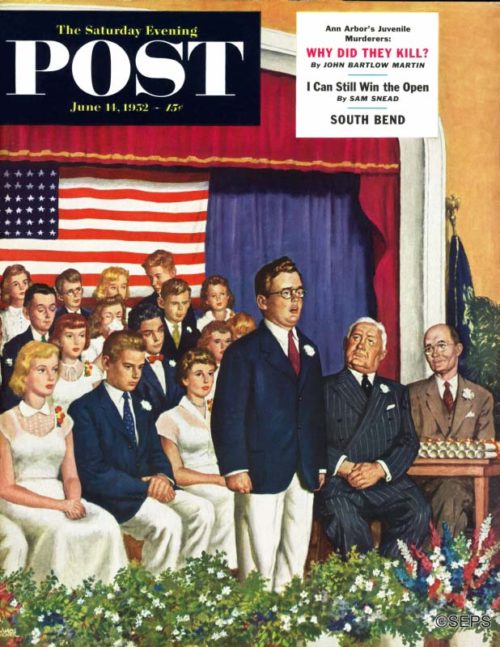
Amos Sewell
June 14, 1952
Once, years ago, a young scholar arose at commencement time to deliver an oration on the Panama Canal, found he had forgotten his entire speech, and started ad-libbing out of the general mass of data he had acquired in the classroom. Everybody vowed it was a grand speech, except his elocution teacher, who nearly had a stroke trying to locate him on her prompting manuscript.
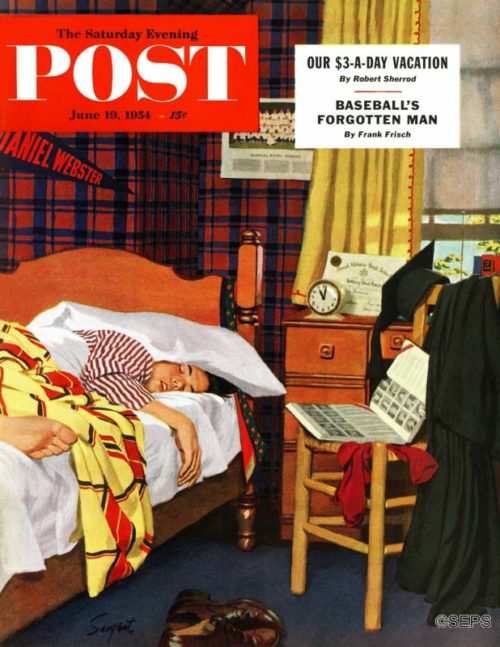
Richard Sargent
June 19, 1954
Now that this young man is going forth from the halls of learning, maybe he is lying there thinking about how his generation soon will he the guardians of civilization, and of what a glorious challenge this is to the youth of today. Or maybe he is asleep. For as Dick Sargent muses with his brush: any guy who manages to finish commencement certainly has forty thousand winks coming.
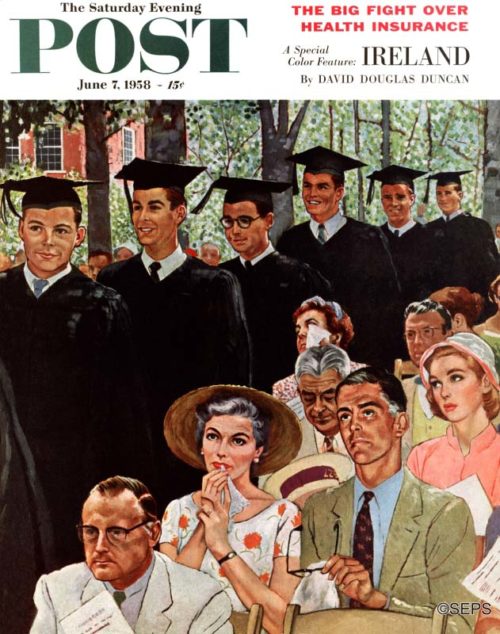
George Hughes
June 7, 1958
Symbolic of a host of graduating Americans, they have an air of quiet confidence, suggesting that as they help mold the future of this cantankerous old world they may be able to make it behave a little better than in the past. Artist George Hughes worked on this cover at Williams College, where everybody did everything possible to make his stay agreeable—well, short of giving him a degree.
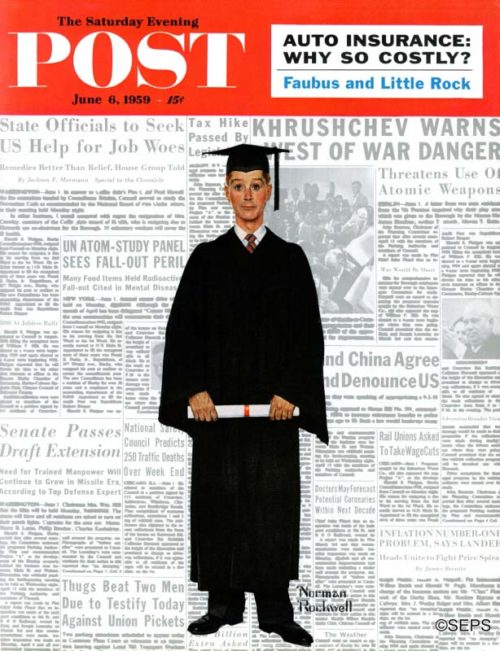
Norman Rockwell
June 6, 1959
Artist Norman Rockwell sketched a couple of undaunted graduates (see below); but then, reflecting on the awfulness of today’s newspaper headlines, he created the bewildered chap on the cover. This one is musing. Boy. aren’t things really screwed up? What to do, I wouldn’t know. But one thing you can bet on: I’ll give it the old college try. Rockwell says, “I like his feet. They look as if he’s standing on eggs.”
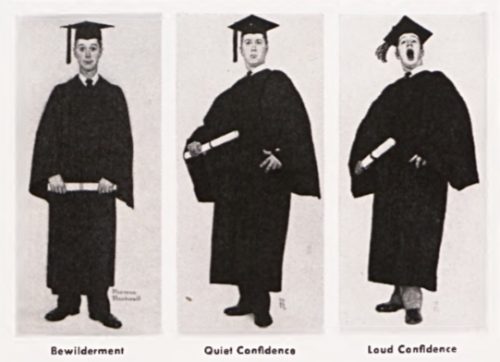
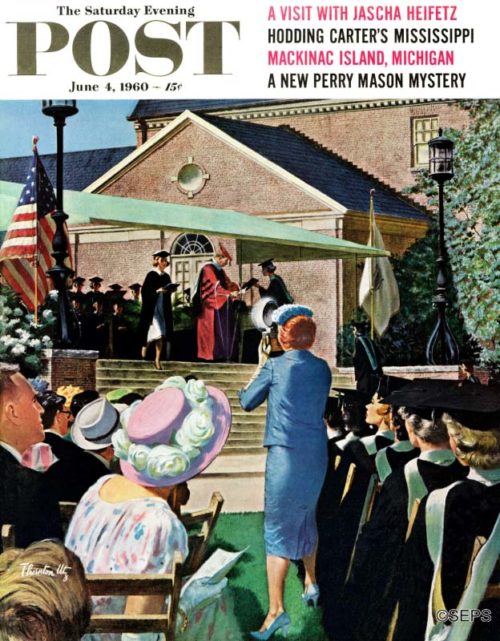
Thornton Utz
June 4, 1960
Artist Thornton Utz’s scene is Smith College, in Northampton, Massachusetts, where in 1960, Congressman Chester Bowles delivered the commencement address. The congressman’s daughter Sarah was among the 500 young ladies receiving bachelor degrees.